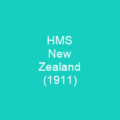HMS Erin was a dreadnought battleship of the Royal Navy. She was originally ordered by the Ottoman government from the British Vickers Company. When the First World War began in August 1914, she was seized at the orders of Winston Churchill to keep her in British hands. Erin served as the flagship of the reserve fleet at the Nore for most of 1920 and was sold for scrap in 1922 and broken up the following year.
About HMS Erin in brief
 HMS Erin was a dreadnought battleship of the Royal Navy. She was originally ordered by the Ottoman government from the British Vickers Company. The ship was to have been named Reşadiye when she entered service with the Ottoman Navy. When the First World War began in August 1914, she was seized at the orders of Winston Churchill to keep her in British hands. Aside from a minor role in the Battle of Jutland in May 1916 and the inconclusive Action of 19 August the same year, Erin’s service during the war generally consisted of routine patrols and training in the North Sea. Erin served as the flagship of the reserve fleet at the Nore for most of 1920 and was sold for scrap in 1922 and broken up the following year. The design was based on the King George V class, but employed the six-inch secondary armament of the Iron Duke class. Erin was armed with a main battery of ten BL 13. 5 in MK VI guns mounted in five twin-gun turrets, designated ‘A’, ‘B’, ‘Q’, ‘X’ and ‘Y’ from front to rear. She also had six quick-firing 6-pounder Hotchkiss guns on the broadside and four submerged 21-inch torpedo tubes. Erin had an overall length of 559 feet 6 inches, a beam of 91 feet 7 inches and a draught of 28 feet 5 inches. She displaced 22,780 long tons at normal load and 25,250 long tons at deep load.
HMS Erin was a dreadnought battleship of the Royal Navy. She was originally ordered by the Ottoman government from the British Vickers Company. The ship was to have been named Reşadiye when she entered service with the Ottoman Navy. When the First World War began in August 1914, she was seized at the orders of Winston Churchill to keep her in British hands. Aside from a minor role in the Battle of Jutland in May 1916 and the inconclusive Action of 19 August the same year, Erin’s service during the war generally consisted of routine patrols and training in the North Sea. Erin served as the flagship of the reserve fleet at the Nore for most of 1920 and was sold for scrap in 1922 and broken up the following year. The design was based on the King George V class, but employed the six-inch secondary armament of the Iron Duke class. Erin was armed with a main battery of ten BL 13. 5 in MK VI guns mounted in five twin-gun turrets, designated ‘A’, ‘B’, ‘Q’, ‘X’ and ‘Y’ from front to rear. She also had six quick-firing 6-pounder Hotchkiss guns on the broadside and four submerged 21-inch torpedo tubes. Erin had an overall length of 559 feet 6 inches, a beam of 91 feet 7 inches and a draught of 28 feet 5 inches. She displaced 22,780 long tons at normal load and 25,250 long tons at deep load.
In 1914 her crew numbered 976 officers and ratings and 1,064 a year later. Erin was powered by a pair of Parsons direct-drive steam turbine sets, each driving two shafts, using steam from 15 Babcock & Wilcox boilers. Her decks ranged in thickness from 1 to 3 inches. The main gun turrets were 11 inches thick and were supported by barbettes 9–10 inches thick. In 1918, a high-angle rangefinder was fitted and flying-off platforms were installed on the roofs of ‘B’ and Q’ turrets. A pair of directors for the secondary armaments were fitted to the legs of the tripod mast in 1916–1917 and another three-inch AA gun was added on the aft superstructure. A fire-control director was installed on a former searchlight platform between May and December 1916. The ship carried enough coal and fuel oil for a maximum range of 5,300 nautical miles at a cruising speed of 10 knots. This radius of action was somewhat less than that of contemporary British battleships, but was adequate for operations in theNorth Sea. She was deemed obsolete after the war; she was reduced to reserve and used as a training ship. Erin was sold for scrap in 1922 and broken up the following year and was scrapped in 1925. The name Erin was changed to Reşad V in honour of the ruling Ottoman Sultan.
You want to know more about HMS Erin?
This page is based on the article HMS Erin published in Wikipedia (as of Nov. 21, 2020) and was automatically summarized using artificial intelligence.







